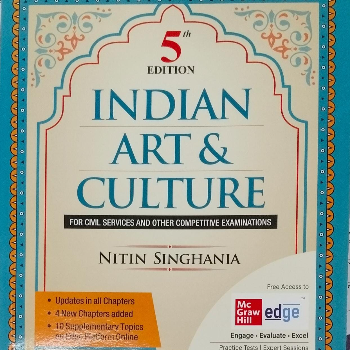In a quiet corner of Mumbai, Asha Patel, a dedicated history teacher, faced a challenge that resonated with educators everywhere. Despite her passion for teaching, she struggled to engage her students with the richness of Indian art and culture. For her students, the subject seemed distant and abstract, a collection of dates and names that held little relevance in their fast-paced, digital lives.
Asha knew she needed a way to make these topics come alive, to connect her students with the vibrant tapestry of their heritage. But how?
The answer came unexpectedly during a leisurely weekend stroll through a local book fair. Amidst stacks of literature, a book titled "Indian Art and Culture" caught her eye. The cover promised a comprehensive exploration of India's artistic legacy, and Asha felt an instinctive pull towards it. As she thumbed through its pages, she saw a potential solution to her classroom conundrum.
The book unfolded the story of India's art and culture with vivid illustrations and engaging narratives. It was more than just a textbook; it was a gateway to India's soul, weaving stories of ancient temples, intricate sculptures, and vibrant festivals into a tapestry that was both educational and captivating. This was precisely what Asha needed—a tool to transform her teaching from mundane recitations into an immersive experience.
With renewed enthusiasm, Asha introduced the book to her classroom. She began each lesson by sharing a story from the book, whether it was about the majestic architecture of the Ajanta caves or the delicate art of miniature painting. The book's vivid imagery and storytelling captivated her students, sparking curiosity and discussions that spilled beyond the classroom walls.
One particular story about the Chola dynasty's bronze sculptures struck a chord with her students. As they learned about the craftsmanship and spiritual significance behind these works, Asha noticed a shift. Her students began to see these pieces not as relics of the past but as living expressions of the culture they were a part of. Inspired, they organized a class project to create their own sculptures, drawing inspiration from traditional techniques while infusing modern themes.
This transformation wasn't just about improved grades or classroom participation; it was emotional. For the first time, Asha saw her students take pride in their heritage. They began to appreciate the depth and diversity of Indian culture, understanding that it was not just history but a living, breathing part of their identity.
Asha's story is a testament to the profound impact that the right educational tools can have. For educators like her, the challenge isn't just about conveying information but about igniting a passion for learning. And sometimes, all it takes is the right resource to bridge the gap between the past and the present, the abstract and the tangible.
"Indian Art and Culture" didn't just enrich Asha's teaching; it transformed her students' perception of themselves and their world. It provided a practical solution to an emotional problem, helping students connect with their heritage in meaningful and engaging ways. This book became more than just a classroom resource—it became a catalyst for change.
As we navigate a world that often feels disconnected from its roots, Asha's story is a reminder of the power of education to inspire and transform. For those seeking to bridge the gap between India's rich past and its vibrant present, this book offers a path forward, one story at a time. So, whether you're an educator, a student, or simply a lover of culture, consider embarking on this journey and discover the transformative power of India's artistic legacy.
Visit Vyaparify Site:
https://id.vyaparify.com/aniket-book-centre 
